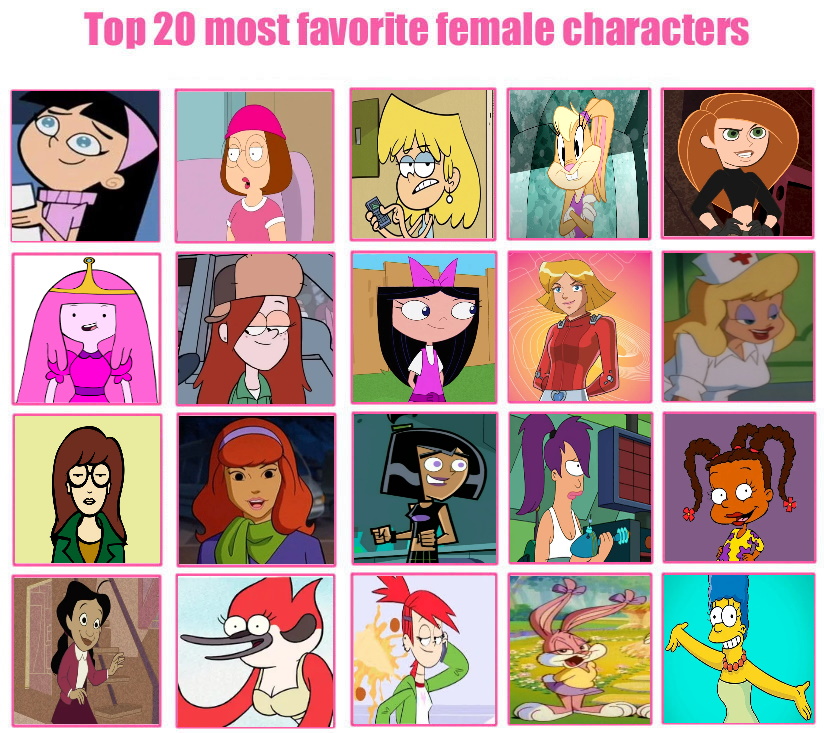Top Female Cartoon Characters: Then And Now
Why do female cartoon characters matter so much? Because representation matters. These vibrant characters are not just pixels on a screen; they are powerful symbols of change, reflecting evolving societal values and inspiring generations of viewers.
From the sassy independence of Daria Morgendorffer to the scientific brilliance of Lunella Lafayette (Moon Girl), animated women have broken barriers and challenged stereotypes. Theyve evolved from damsels in distress to complex figures with their own agency, dreams, and flaws. Their presence in animation, a medium often associated with children's entertainment, underscores the crucial role these characters play in shaping perceptions and fostering inclusivity.
| Name | Daria Morgendorffer |
|---|---|
| Created By | Glenn Eichler and Susie Lewis Lynn |
| First Appearance | Beavis and Butt-head (1993) (as a recurring character); Daria (1997) (as main character) |
| Known For | Witty sarcasm, intellectualism, social commentary |
| Impact | Became a cultural icon of the 1990s, representing teenage angst and intellectual independence. Challenged stereotypical portrayals of teenage girls. |
| Reference | Daria Morgendorffer Fandom Wiki |
The 1990s, often considered a golden age of animation, witnessed a surge in memorable female characters. These weren't just sidekicks or love interests; they were protagonists driving their own narratives. Shows like Daria offered a refreshing take on teenage life, tackling complex themes with wit and intelligence. Daria's cynical observations on high school, social dynamics, and popular culture resonated deeply with audiences, making her an icon for a generation grappling with similar issues.
Beyond the '90s, the evolution continues. Lunella Lafayette, a brilliant 13-year-old scientist known as Moon Girl, exemplifies the modern female cartoon character. She's a problem-solver, an innovator, and a protector of her community, demonstrating that intelligence and strength come in all ages, genders, and backgrounds. Her partnership with Devil Dinosaur further subverts traditional narratives, showcasing a unique bond between a young girl and her prehistoric companion.
The Powerpuff GirlsBlossom, Bubbles, and Buttercupare another prime example of how female characters can be both powerful and nuanced. Created in a lab, these pint-sized superheroes defy expectations, battling villains and saving the day with their unique abilities and teamwork. Their popularity spans decades, proving their enduring appeal across generations.
The influence of Disney princesses cannot be overlooked. While early princesses often conformed to traditional gender roles, contemporary characters like Moana and Merida challenge these conventions. They exhibit courage, independence, and a determination to forge their own paths. This shift reflects a broader cultural conversation about female empowerment, demonstrating how animation can both mirror and influence societal progress.
Even in ensembles, female characters shine. Velma Dinkley, the bespectacled brains of the Mystery Incorporated gang, showcases the importance of intelligence and critical thinking. Her problem-solving skills are essential to the team's success, proving that intellect is just as valuable as physical strength. Misty from Pokmon adds another layer of representation, embodying a passion for water Pokmon and demonstrating that girls can thrive in traditionally male-dominated fields.
The journey of female cartoon characters is far from over. As animation continues to evolve, so too will the representation of women on screen. These characters are more than just entertainment; they are reflections of our hopes, our struggles, and our evolving understanding of what it means to be a woman in the world. Their stories empower, inspire, and remind us that strength, intelligence, and compassion are qualities to be celebrated, regardless of gender.
| Decade | Notable Female Cartoon Characters | Key Themes |
|---|---|---|
| 1980s | Jem, Rainbow Brite, She-Ra | Magic, friendship, empowerment |
| 1990s | Daria Morgendorffer, Sailor Moon, The Powerpuff Girls | Individuality, girl power, social commentary |
| 2000s | Kim Possible, Raven (Teen Titans), Velma Dinkley (What's New, Scooby-Doo?) | Action, adventure, intelligence |
| 2010s-Present | Lunella Lafayette (Moon Girl), Moana, Merida | Diversity, STEM, challenging traditional narratives |
From the classic Looney Tunes shorts, with their witty slapstick and memorable characters, to contemporary animated shows tackling complex social issues, the landscape of animation continues to evolve. But one thing remains constant: the enduring power of compelling characters, particularly strong female characters, to shape hearts and minds across generations.
As we celebrate Women's History Month and beyond, its vital to acknowledge the impact of these animated heroines. They inspire us to embrace our individuality, challenge societal norms, and celebrate the diverse tapestry of female experiences. They teach us that strength takes many forms, from intellectual prowess to unwavering compassion. And they remind us that representation truly matters, both on screen and in the world beyond.



Detail Author:
- Name : Jacinto Walsh
- Email : phoebe.wiza@volkman.com
- Birthdate : 1997-04-19
- Address : 538 Olson Plains Suite 810 North Monica, DE 06418-4121
- Phone : 1-986-924-5038
- Company : King Inc
- Job : Public Relations Specialist
- Bio : Libero eos deserunt dolor magni et. Aliquid laudantium necessitatibus ut perspiciatis porro qui blanditiis totam. Iure et porro dignissimos aut. Consequatur sed saepe et non.